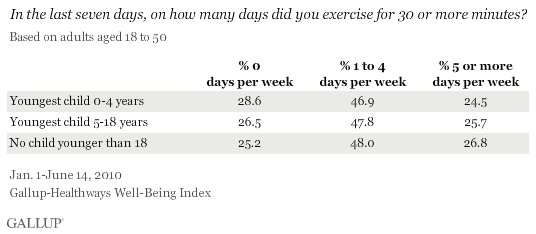WASHINGTON, D.C. -- Among Americans aged 18 to 50, those with children 18 years old or younger at home are less likely to report frequent exercise than are those with no child younger than 18 at home. Parents who have a child younger than age 4 also report lower levels of frequent exercise (24.5%), defined here as at least 30 minutes five or more days per week, than those with a child 5 to 18 years of age (25.7%).

Parents with a child 18 years old or younger are also more likely than those with no child younger than 18 to say that they exercise for at least 30 minutes zero days per week. Those with younger children are more likely to report not exercising on any single day in a week than are those with a child between the ages of 5 and 18.
It is important to note that the differences in exercise frequency between parents with a child aged 18 or younger and those who have no child younger than 18 at home are small, but measurable. Perhaps more significant is that approximately one-quarter of those with children and those without report exercising for at least 30 minutes no days per week.
These findings are based on more than 59,000 interviews with Americans, aged 18 to 50, from January-June 2010, conducted as part of the Gallup-Healthways Well-Being Index. Additional analysis shows that the same relationships hold for men and women in this age range. Gallup and Healthways ask all American adults about their exercise habits daily, and so far in 2010, find frequent exercise on the rise compared with last year.
Parents More Likely to Be Overweight and Obese
Parents with children aged 18 or younger are also slightly more likely than those without a child in their home to be obese or overweight, with parents of 5- to 18-year-olds the most likely to have a body mass index that puts them either in the obese or overweight category.

Parents are also less likely to be normal weight than are those adults with no child in their home. Gallup previously reported that obesity among all U.S. adults remains high so far in 2010 and normal weight levels are low compared with 2008.
Bottom Line
While the exercise habits and weight issues of parents themselves are a significant problem on their own for those individuals and for the United States in terms of quality of life and healthcare costs, the potential effects on the children of these parents represent an even bigger crisis. Parental health habits have an impact on children and numerous studies have found that children who have obese parents are more likely to be obese as adults. First lady Michelle Obama launched a massive campaign to address childhood obesity in February of this year, part of which is aimed at improving parents' health habits. The empirical effects of Mrs. Obama's efforts are yet to be seen, but the "Let's Move" initiative and related programs are set to receive up to $10 billion in federal funds over the next 10 years, and throughout that time and beyond, Gallup and Healthways will continue to track parents' exercise frequency and obesity levels.
Learn more about the Gallup-Healthways Well-Being Index.
Survey Methods
Results are based on telephone interviews conducted as part of the Gallup Healthways Well-Being Index survey on Jan. 1-June 14, 2010, with a random sample of 59,106 adults, aged 18 to 50, living in all 50 U.S. states and the District of Columbia, selected using random-digit-dial sampling. Of these, 13,600 respondents had at least one child in the household that was zero to four years of age, 21,605 respondents had a youngest child in the household that was between 5 and 18, and another 23,571 had no child younger than 18 living in the household.
For results based on the total sample of 59,106 national adults aged 18-50, one can say with 95% confidence that the maximum margin of sampling error is ±0.5 percentage points.
For results based on the total sample of each of the three reported subgroups, one can say with 95% confidence that the maximum margin of sampling error is ±1 percentage points.
Interviews are conducted with respondents on landline telephones and cellular phones, with interviews conducted in Spanish for respondents who are primarily Spanish-speaking. Each daily sample includes a minimum quota of 150 cell phone respondents and 850 landline respondents, with additional minimum quotas among landline respondents for gender within region. Landline respondents are chosen at random within each household on the basis of which member had the most recent birthday.
Samples are weighted by gender, age, race, Hispanic ethnicity, education, region, adults in the household, cell phone-only status, cell phone-mostly status, and phone lines. Demographic weighting targets are based on the March 2009 Current Population Survey figures for the aged 18 and older non-institutionalized population living in U.S. telephone households. All reported margins of sampling error include the computed design effects for weighting and sample design.
In addition to sampling error, question wording and practical difficulties in conducting surveys can introduce error or bias into the findings of public opinion polls.
For more details on Gallup's polling methodology, visit www.gallup.com.
About the Gallup-Healthways Well-Being Index
The Gallup-Healthways Well-Being Index measures the daily pulse of U.S. well-being and provides best-in-class solutions for a healthier world. To learn more, please visit well-beingindex.com.
